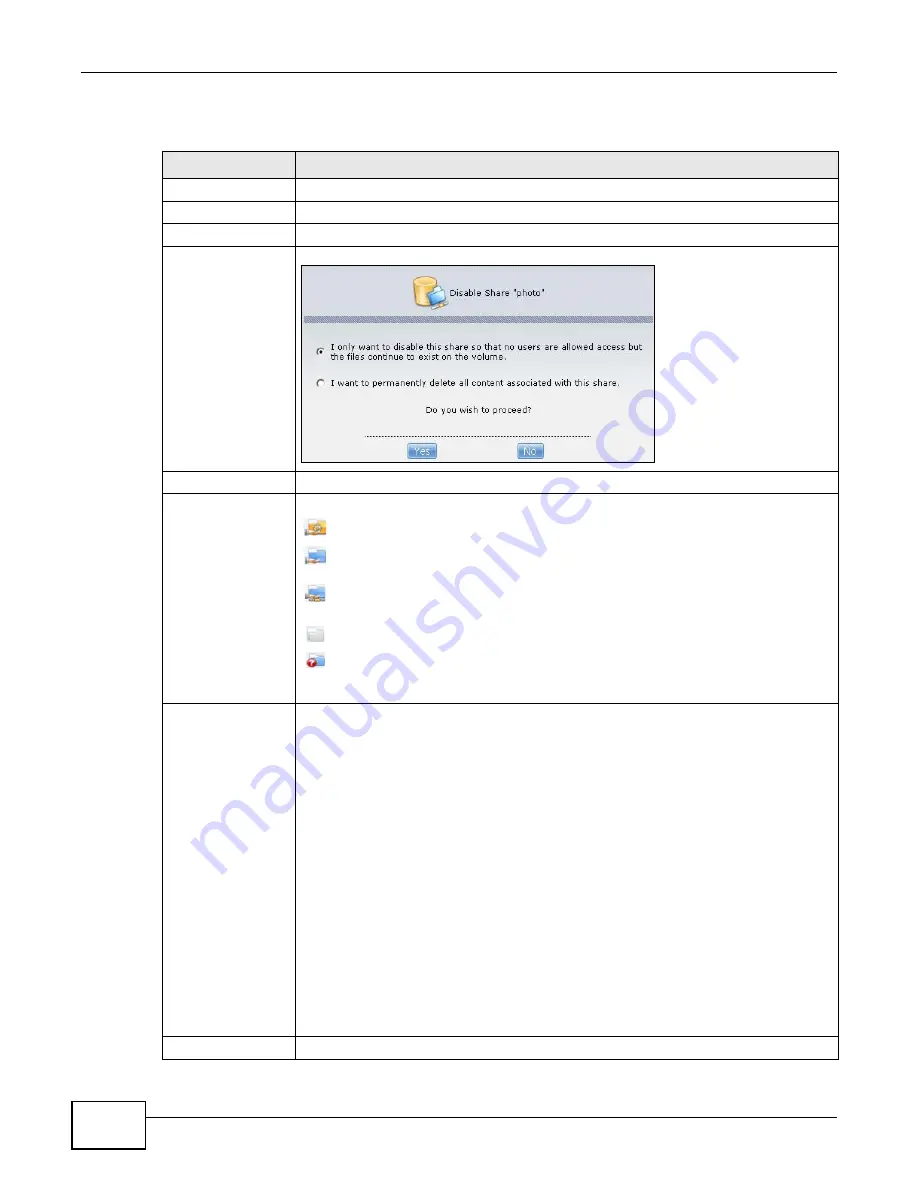
Chapter 17 Shares
Media Server User’s Guide
318
The following table describes the labels in this screen.
Table 108
Sharing > Shares
LABEL
DESCRIPTION
Add Share
Click this to create a new share.
Recycle Bin
Click this to configure recycle bins.
Edit Share
Select a share and click this to edit the share.
Delete Share
Select a share and click this to remove or restrict access to the share.
Share Browser
Select a share and click this to browse the share’s contents.
Status
This field displays the share icons.
represents a Built-in share on a volume on the internal hard drives.
represents an Auto-SATA, Predefined, or User-Created share on a volume on
the internal hard drives.
represents an Auto or User-Created share on a volume on the external (USB)
devices.
represents a disabled share that no user can access.
represents a missing share. The NSA cannot find the hard disk associated with the
share (the disk may be removed from the NSA for example). You may install the disk
back to the NSA to recover the share, or you may delete the share from the NSA.
Share Type
The NSA automatically creates an Auto-SATA share for each internal SATA volume. The
auto-SATA share has the same name as the volume and is the volume’s root (or
“master”) share. It contains all of the volume’s shares. All new shares you create on the
volume are also automatically included in the auto-SATA share. You cannot delete, edit,
or use the share browser with the auto-SATA share.
Note: Use the admin account to map the auto SATA share to a Windows network drive.
This gives the administrator convenient access to all of the volume’s shares
through a single Windows network drive. External disk (volume) shares must still
be mapped individually.
This field displays Built-in for system shares. You cannot delete these shares. These
are the public and admin shares.
This field displays Predefined for default shares. You cannot delete these shares. These
are the video, music, and photo shares.
This field displays User-created for shares that an administrator has created. You can
delete these shares.
This field displays Auto for shares that are automatically created on an external (USB)
device when a user plugs in the device.
Share Name
This field displays the share’s names.
Summary of Contents for NSA320
Page 4: ...Contents Overview Media Server User s Guide 4...
Page 14: ...Table of Contents Media Server User s Guide 14...
Page 15: ...15 PART I User s Guide...
Page 16: ...16...
Page 20: ...Chapter 1 Getting to Know Your NSA Media Server User s Guide 20...
Page 40: ...Chapter 3 zCloud Media Server User s Guide 40...
Page 125: ...Chapter 5 Tutorials Media Server User s Guide 125 5 Click Get Certificate...
Page 145: ...145 PART II Technical Reference...
Page 146: ...146...
Page 150: ...Chapter 6 Status Screen Media Server User s Guide 150...
Page 160: ...Chapter 7 System Setting Media Server User s Guide 160...
Page 174: ...Chapter 8 Storage Media Server User s Guide 174...
Page 284: ...Chapter 11 Packages Media Server User s Guide 284...
Page 306: ...Chapter 14 Using Time Machine with the NSA Media Server User s Guide 306...
















































